University Case Study: Apple iPhone and Global Business Operations
VerifiedAdded on 2022/11/13
|9
|2226
|350
Case Study
AI Summary
This case study analyzes Apple's iPhone, examining its global operations, supply chain, and the economic implications of manufacturing and outsourcing. The study explores the distribution of value across different countries, the role of companies like Foxconn, and the ethical concerns related to labor practices. It delves into the opportunities and threats Apple faces, including competition, imitation, and labor costs. The case also discusses stakeholder relationships, the potential for bringing manufacturing back to the U.S., and the impact of working conditions in supplier factories on Apple's reputation. The analysis considers the balance between profitability, ethical considerations, and customer demands, ultimately offering insights into the complexities of global business in the technology sector. The case study references various reports and academic articles to support its findings.
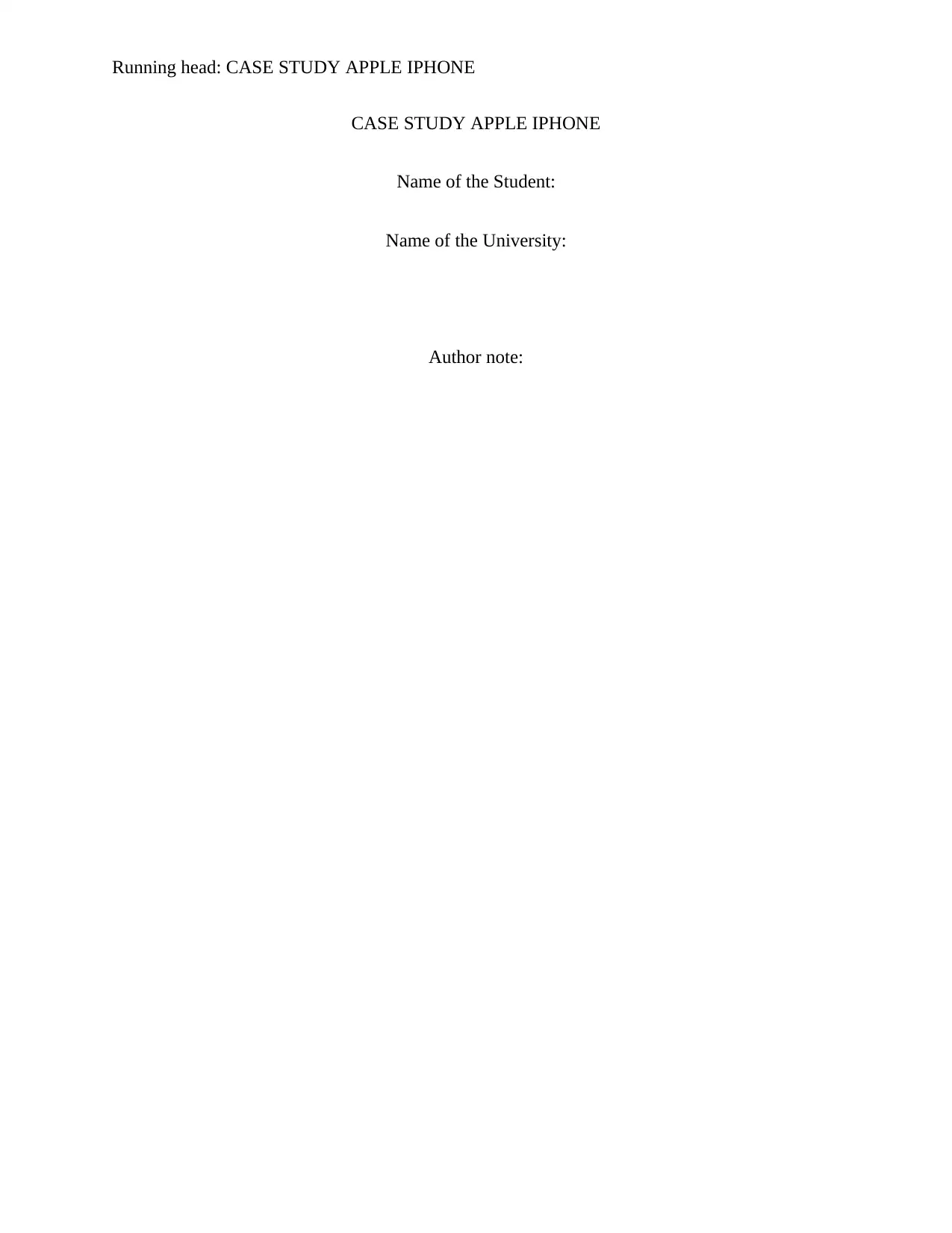
Running head: CASE STUDY APPLE IPHONE
CASE STUDY APPLE IPHONE
Name of the Student:
Name of the University:
Author note:
CASE STUDY APPLE IPHONE
Name of the Student:
Name of the University:
Author note:
Paraphrase This Document
Need a fresh take? Get an instant paraphrase of this document with our AI Paraphraser
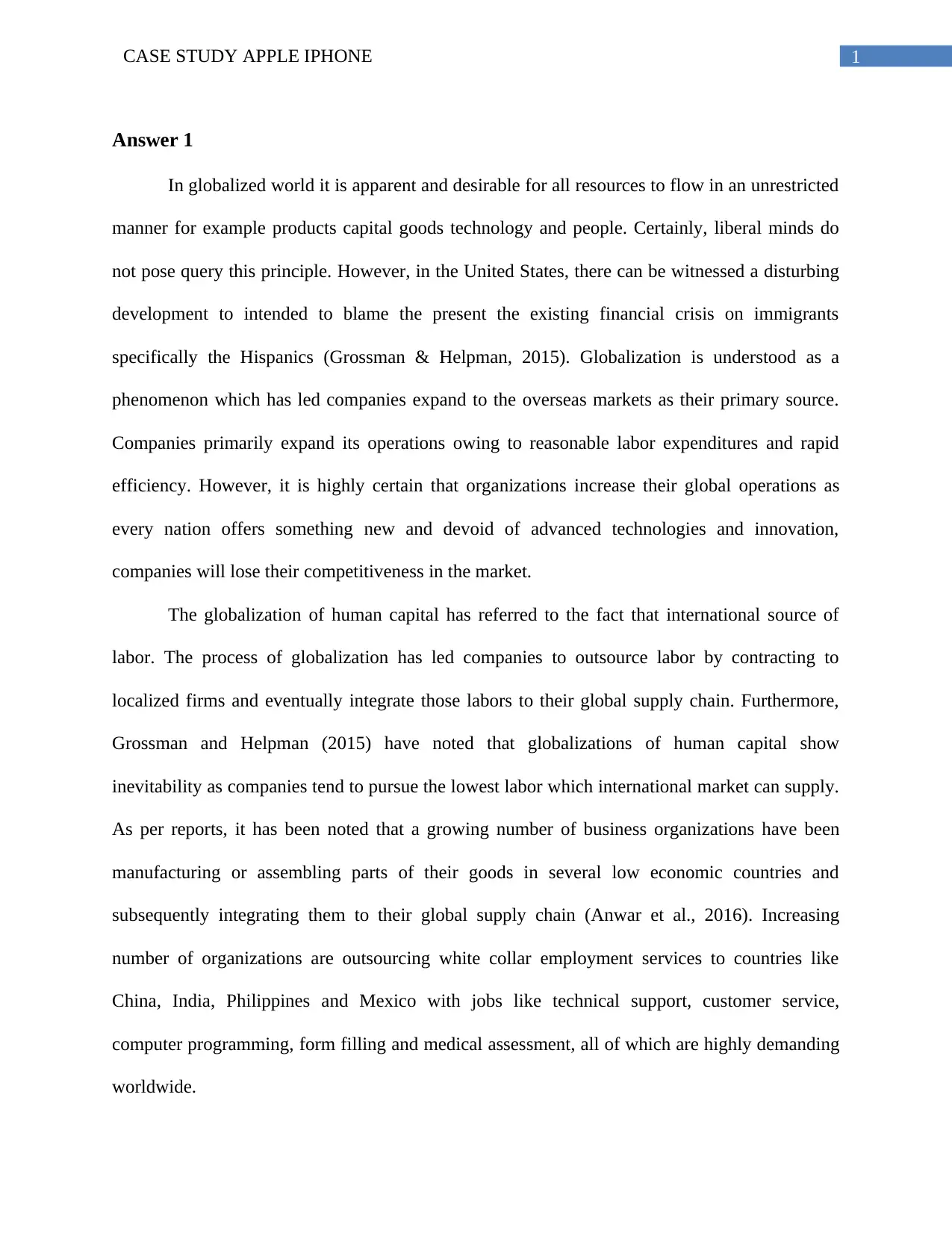
1CASE STUDY APPLE IPHONE
Answer 1
In globalized world it is apparent and desirable for all resources to flow in an unrestricted
manner for example products capital goods technology and people. Certainly, liberal minds do
not pose query this principle. However, in the United States, there can be witnessed a disturbing
development to intended to blame the present the existing financial crisis on immigrants
specifically the Hispanics (Grossman & Helpman, 2015). Globalization is understood as a
phenomenon which has led companies expand to the overseas markets as their primary source.
Companies primarily expand its operations owing to reasonable labor expenditures and rapid
efficiency. However, it is highly certain that organizations increase their global operations as
every nation offers something new and devoid of advanced technologies and innovation,
companies will lose their competitiveness in the market.
The globalization of human capital has referred to the fact that international source of
labor. The process of globalization has led companies to outsource labor by contracting to
localized firms and eventually integrate those labors to their global supply chain. Furthermore,
Grossman and Helpman (2015) have noted that globalizations of human capital show
inevitability as companies tend to pursue the lowest labor which international market can supply.
As per reports, it has been noted that a growing number of business organizations have been
manufacturing or assembling parts of their goods in several low economic countries and
subsequently integrating them to their global supply chain (Anwar et al., 2016). Increasing
number of organizations are outsourcing white collar employment services to countries like
China, India, Philippines and Mexico with jobs like technical support, customer service,
computer programming, form filling and medical assessment, all of which are highly demanding
worldwide.
Answer 1
In globalized world it is apparent and desirable for all resources to flow in an unrestricted
manner for example products capital goods technology and people. Certainly, liberal minds do
not pose query this principle. However, in the United States, there can be witnessed a disturbing
development to intended to blame the present the existing financial crisis on immigrants
specifically the Hispanics (Grossman & Helpman, 2015). Globalization is understood as a
phenomenon which has led companies expand to the overseas markets as their primary source.
Companies primarily expand its operations owing to reasonable labor expenditures and rapid
efficiency. However, it is highly certain that organizations increase their global operations as
every nation offers something new and devoid of advanced technologies and innovation,
companies will lose their competitiveness in the market.
The globalization of human capital has referred to the fact that international source of
labor. The process of globalization has led companies to outsource labor by contracting to
localized firms and eventually integrate those labors to their global supply chain. Furthermore,
Grossman and Helpman (2015) have noted that globalizations of human capital show
inevitability as companies tend to pursue the lowest labor which international market can supply.
As per reports, it has been noted that a growing number of business organizations have been
manufacturing or assembling parts of their goods in several low economic countries and
subsequently integrating them to their global supply chain (Anwar et al., 2016). Increasing
number of organizations are outsourcing white collar employment services to countries like
China, India, Philippines and Mexico with jobs like technical support, customer service,
computer programming, form filling and medical assessment, all of which are highly demanding
worldwide.
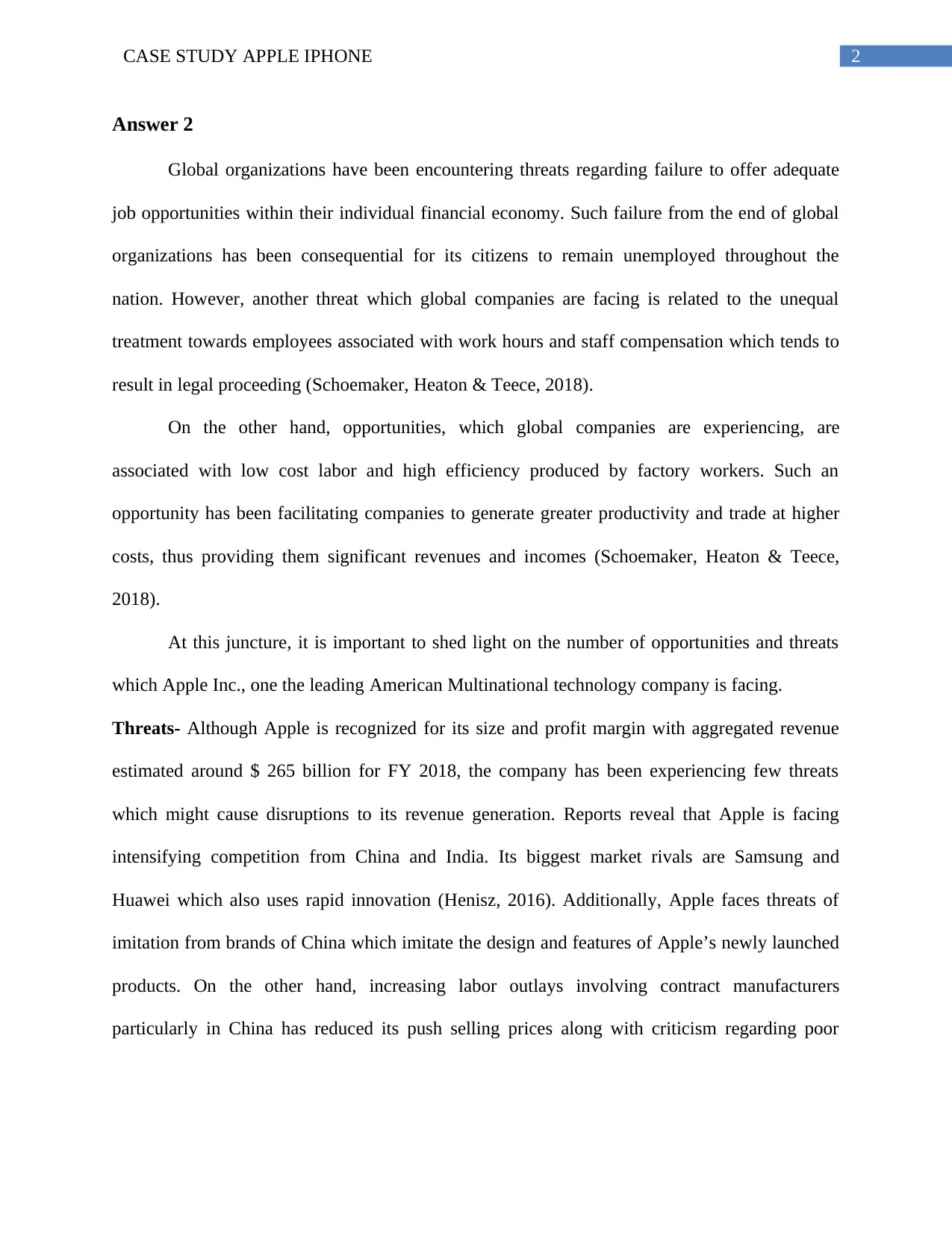
2CASE STUDY APPLE IPHONE
Answer 2
Global organizations have been encountering threats regarding failure to offer adequate
job opportunities within their individual financial economy. Such failure from the end of global
organizations has been consequential for its citizens to remain unemployed throughout the
nation. However, another threat which global companies are facing is related to the unequal
treatment towards employees associated with work hours and staff compensation which tends to
result in legal proceeding (Schoemaker, Heaton & Teece, 2018).
On the other hand, opportunities, which global companies are experiencing, are
associated with low cost labor and high efficiency produced by factory workers. Such an
opportunity has been facilitating companies to generate greater productivity and trade at higher
costs, thus providing them significant revenues and incomes (Schoemaker, Heaton & Teece,
2018).
At this juncture, it is important to shed light on the number of opportunities and threats
which Apple Inc., one the leading American Multinational technology company is facing.
Threats- Although Apple is recognized for its size and profit margin with aggregated revenue
estimated around $ 265 billion for FY 2018, the company has been experiencing few threats
which might cause disruptions to its revenue generation. Reports reveal that Apple is facing
intensifying competition from China and India. Its biggest market rivals are Samsung and
Huawei which also uses rapid innovation (Henisz, 2016). Additionally, Apple faces threats of
imitation from brands of China which imitate the design and features of Apple’s newly launched
products. On the other hand, increasing labor outlays involving contract manufacturers
particularly in China has reduced its push selling prices along with criticism regarding poor
Answer 2
Global organizations have been encountering threats regarding failure to offer adequate
job opportunities within their individual financial economy. Such failure from the end of global
organizations has been consequential for its citizens to remain unemployed throughout the
nation. However, another threat which global companies are facing is related to the unequal
treatment towards employees associated with work hours and staff compensation which tends to
result in legal proceeding (Schoemaker, Heaton & Teece, 2018).
On the other hand, opportunities, which global companies are experiencing, are
associated with low cost labor and high efficiency produced by factory workers. Such an
opportunity has been facilitating companies to generate greater productivity and trade at higher
costs, thus providing them significant revenues and incomes (Schoemaker, Heaton & Teece,
2018).
At this juncture, it is important to shed light on the number of opportunities and threats
which Apple Inc., one the leading American Multinational technology company is facing.
Threats- Although Apple is recognized for its size and profit margin with aggregated revenue
estimated around $ 265 billion for FY 2018, the company has been experiencing few threats
which might cause disruptions to its revenue generation. Reports reveal that Apple is facing
intensifying competition from China and India. Its biggest market rivals are Samsung and
Huawei which also uses rapid innovation (Henisz, 2016). Additionally, Apple faces threats of
imitation from brands of China which imitate the design and features of Apple’s newly launched
products. On the other hand, increasing labor outlays involving contract manufacturers
particularly in China has reduced its push selling prices along with criticism regarding poor
⊘ This is a preview!⊘
Do you want full access?
Subscribe today to unlock all pages.

Trusted by 1+ million students worldwide
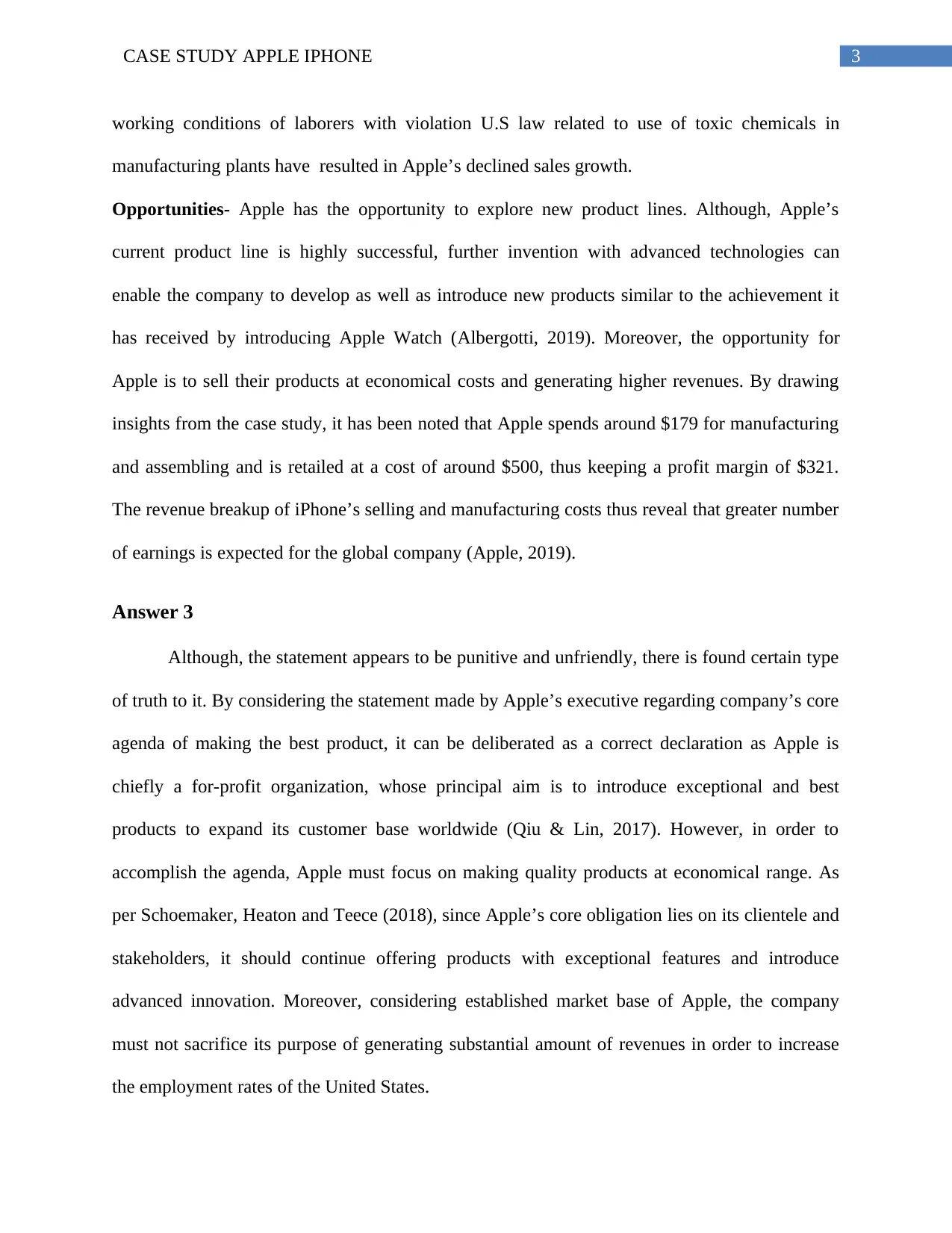
3CASE STUDY APPLE IPHONE
working conditions of laborers with violation U.S law related to use of toxic chemicals in
manufacturing plants have resulted in Apple’s declined sales growth.
Opportunities- Apple has the opportunity to explore new product lines. Although, Apple’s
current product line is highly successful, further invention with advanced technologies can
enable the company to develop as well as introduce new products similar to the achievement it
has received by introducing Apple Watch (Albergotti, 2019). Moreover, the opportunity for
Apple is to sell their products at economical costs and generating higher revenues. By drawing
insights from the case study, it has been noted that Apple spends around $179 for manufacturing
and assembling and is retailed at a cost of around $500, thus keeping a profit margin of $321.
The revenue breakup of iPhone’s selling and manufacturing costs thus reveal that greater number
of earnings is expected for the global company (Apple, 2019).
Answer 3
Although, the statement appears to be punitive and unfriendly, there is found certain type
of truth to it. By considering the statement made by Apple’s executive regarding company’s core
agenda of making the best product, it can be deliberated as a correct declaration as Apple is
chiefly a for-profit organization, whose principal aim is to introduce exceptional and best
products to expand its customer base worldwide (Qiu & Lin, 2017). However, in order to
accomplish the agenda, Apple must focus on making quality products at economical range. As
per Schoemaker, Heaton and Teece (2018), since Apple’s core obligation lies on its clientele and
stakeholders, it should continue offering products with exceptional features and introduce
advanced innovation. Moreover, considering established market base of Apple, the company
must not sacrifice its purpose of generating substantial amount of revenues in order to increase
the employment rates of the United States.
working conditions of laborers with violation U.S law related to use of toxic chemicals in
manufacturing plants have resulted in Apple’s declined sales growth.
Opportunities- Apple has the opportunity to explore new product lines. Although, Apple’s
current product line is highly successful, further invention with advanced technologies can
enable the company to develop as well as introduce new products similar to the achievement it
has received by introducing Apple Watch (Albergotti, 2019). Moreover, the opportunity for
Apple is to sell their products at economical costs and generating higher revenues. By drawing
insights from the case study, it has been noted that Apple spends around $179 for manufacturing
and assembling and is retailed at a cost of around $500, thus keeping a profit margin of $321.
The revenue breakup of iPhone’s selling and manufacturing costs thus reveal that greater number
of earnings is expected for the global company (Apple, 2019).
Answer 3
Although, the statement appears to be punitive and unfriendly, there is found certain type
of truth to it. By considering the statement made by Apple’s executive regarding company’s core
agenda of making the best product, it can be deliberated as a correct declaration as Apple is
chiefly a for-profit organization, whose principal aim is to introduce exceptional and best
products to expand its customer base worldwide (Qiu & Lin, 2017). However, in order to
accomplish the agenda, Apple must focus on making quality products at economical range. As
per Schoemaker, Heaton and Teece (2018), since Apple’s core obligation lies on its clientele and
stakeholders, it should continue offering products with exceptional features and introduce
advanced innovation. Moreover, considering established market base of Apple, the company
must not sacrifice its purpose of generating substantial amount of revenues in order to increase
the employment rates of the United States.
Paraphrase This Document
Need a fresh take? Get an instant paraphrase of this document with our AI Paraphraser
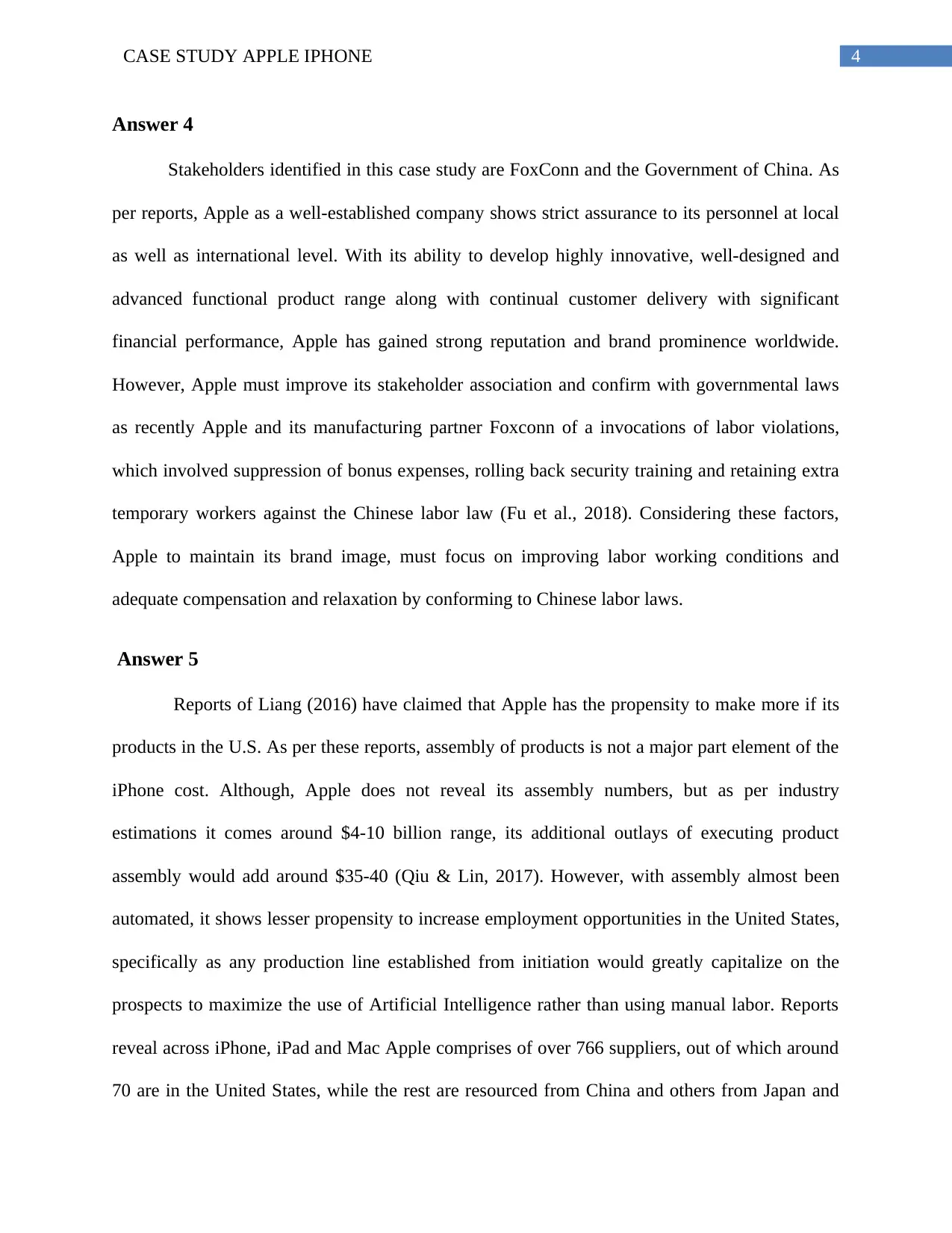
4CASE STUDY APPLE IPHONE
Answer 4
Stakeholders identified in this case study are FoxConn and the Government of China. As
per reports, Apple as a well-established company shows strict assurance to its personnel at local
as well as international level. With its ability to develop highly innovative, well-designed and
advanced functional product range along with continual customer delivery with significant
financial performance, Apple has gained strong reputation and brand prominence worldwide.
However, Apple must improve its stakeholder association and confirm with governmental laws
as recently Apple and its manufacturing partner Foxconn of a invocations of labor violations,
which involved suppression of bonus expenses, rolling back security training and retaining extra
temporary workers against the Chinese labor law (Fu et al., 2018). Considering these factors,
Apple to maintain its brand image, must focus on improving labor working conditions and
adequate compensation and relaxation by conforming to Chinese labor laws.
Answer 5
Reports of Liang (2016) have claimed that Apple has the propensity to make more if its
products in the U.S. As per these reports, assembly of products is not a major part element of the
iPhone cost. Although, Apple does not reveal its assembly numbers, but as per industry
estimations it comes around $4-10 billion range, its additional outlays of executing product
assembly would add around $35-40 (Qiu & Lin, 2017). However, with assembly almost been
automated, it shows lesser propensity to increase employment opportunities in the United States,
specifically as any production line established from initiation would greatly capitalize on the
prospects to maximize the use of Artificial Intelligence rather than using manual labor. Reports
reveal across iPhone, iPad and Mac Apple comprises of over 766 suppliers, out of which around
70 are in the United States, while the rest are resourced from China and others from Japan and
Answer 4
Stakeholders identified in this case study are FoxConn and the Government of China. As
per reports, Apple as a well-established company shows strict assurance to its personnel at local
as well as international level. With its ability to develop highly innovative, well-designed and
advanced functional product range along with continual customer delivery with significant
financial performance, Apple has gained strong reputation and brand prominence worldwide.
However, Apple must improve its stakeholder association and confirm with governmental laws
as recently Apple and its manufacturing partner Foxconn of a invocations of labor violations,
which involved suppression of bonus expenses, rolling back security training and retaining extra
temporary workers against the Chinese labor law (Fu et al., 2018). Considering these factors,
Apple to maintain its brand image, must focus on improving labor working conditions and
adequate compensation and relaxation by conforming to Chinese labor laws.
Answer 5
Reports of Liang (2016) have claimed that Apple has the propensity to make more if its
products in the U.S. As per these reports, assembly of products is not a major part element of the
iPhone cost. Although, Apple does not reveal its assembly numbers, but as per industry
estimations it comes around $4-10 billion range, its additional outlays of executing product
assembly would add around $35-40 (Qiu & Lin, 2017). However, with assembly almost been
automated, it shows lesser propensity to increase employment opportunities in the United States,
specifically as any production line established from initiation would greatly capitalize on the
prospects to maximize the use of Artificial Intelligence rather than using manual labor. Reports
reveal across iPhone, iPad and Mac Apple comprises of over 766 suppliers, out of which around
70 are in the United States, while the rest are resourced from China and others from Japan and
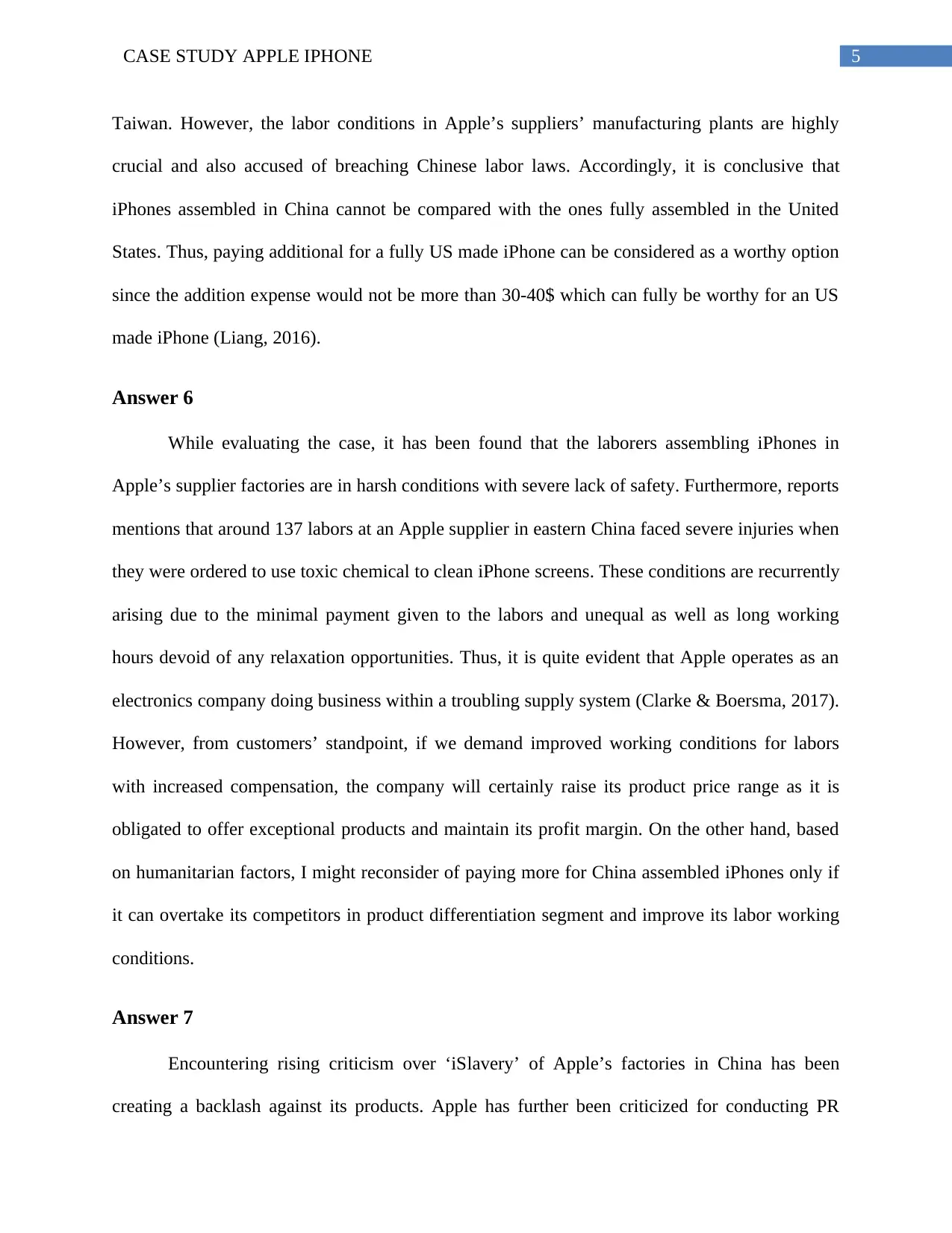
5CASE STUDY APPLE IPHONE
Taiwan. However, the labor conditions in Apple’s suppliers’ manufacturing plants are highly
crucial and also accused of breaching Chinese labor laws. Accordingly, it is conclusive that
iPhones assembled in China cannot be compared with the ones fully assembled in the United
States. Thus, paying additional for a fully US made iPhone can be considered as a worthy option
since the addition expense would not be more than 30-40$ which can fully be worthy for an US
made iPhone (Liang, 2016).
Answer 6
While evaluating the case, it has been found that the laborers assembling iPhones in
Apple’s supplier factories are in harsh conditions with severe lack of safety. Furthermore, reports
mentions that around 137 labors at an Apple supplier in eastern China faced severe injuries when
they were ordered to use toxic chemical to clean iPhone screens. These conditions are recurrently
arising due to the minimal payment given to the labors and unequal as well as long working
hours devoid of any relaxation opportunities. Thus, it is quite evident that Apple operates as an
electronics company doing business within a troubling supply system (Clarke & Boersma, 2017).
However, from customers’ standpoint, if we demand improved working conditions for labors
with increased compensation, the company will certainly raise its product price range as it is
obligated to offer exceptional products and maintain its profit margin. On the other hand, based
on humanitarian factors, I might reconsider of paying more for China assembled iPhones only if
it can overtake its competitors in product differentiation segment and improve its labor working
conditions.
Answer 7
Encountering rising criticism over ‘iSlavery’ of Apple’s factories in China has been
creating a backlash against its products. Apple has further been criticized for conducting PR
Taiwan. However, the labor conditions in Apple’s suppliers’ manufacturing plants are highly
crucial and also accused of breaching Chinese labor laws. Accordingly, it is conclusive that
iPhones assembled in China cannot be compared with the ones fully assembled in the United
States. Thus, paying additional for a fully US made iPhone can be considered as a worthy option
since the addition expense would not be more than 30-40$ which can fully be worthy for an US
made iPhone (Liang, 2016).
Answer 6
While evaluating the case, it has been found that the laborers assembling iPhones in
Apple’s supplier factories are in harsh conditions with severe lack of safety. Furthermore, reports
mentions that around 137 labors at an Apple supplier in eastern China faced severe injuries when
they were ordered to use toxic chemical to clean iPhone screens. These conditions are recurrently
arising due to the minimal payment given to the labors and unequal as well as long working
hours devoid of any relaxation opportunities. Thus, it is quite evident that Apple operates as an
electronics company doing business within a troubling supply system (Clarke & Boersma, 2017).
However, from customers’ standpoint, if we demand improved working conditions for labors
with increased compensation, the company will certainly raise its product price range as it is
obligated to offer exceptional products and maintain its profit margin. On the other hand, based
on humanitarian factors, I might reconsider of paying more for China assembled iPhones only if
it can overtake its competitors in product differentiation segment and improve its labor working
conditions.
Answer 7
Encountering rising criticism over ‘iSlavery’ of Apple’s factories in China has been
creating a backlash against its products. Apple has further been criticized for conducting PR
⊘ This is a preview!⊘
Do you want full access?
Subscribe today to unlock all pages.

Trusted by 1+ million students worldwide
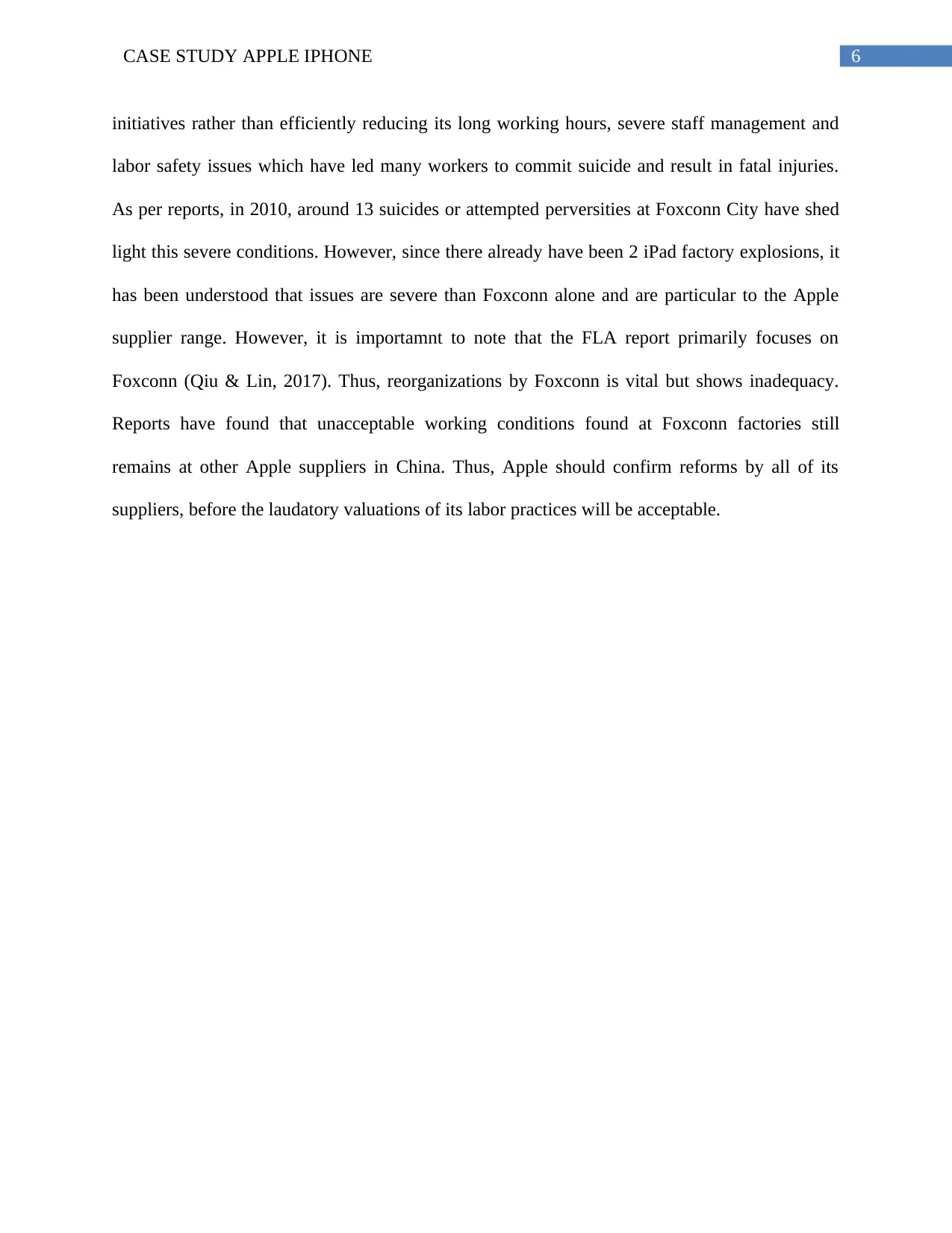
6CASE STUDY APPLE IPHONE
initiatives rather than efficiently reducing its long working hours, severe staff management and
labor safety issues which have led many workers to commit suicide and result in fatal injuries.
As per reports, in 2010, around 13 suicides or attempted perversities at Foxconn City have shed
light this severe conditions. However, since there already have been 2 iPad factory explosions, it
has been understood that issues are severe than Foxconn alone and are particular to the Apple
supplier range. However, it is importamnt to note that the FLA report primarily focuses on
Foxconn (Qiu & Lin, 2017). Thus, reorganizations by Foxconn is vital but shows inadequacy.
Reports have found that unacceptable working conditions found at Foxconn factories still
remains at other Apple suppliers in China. Thus, Apple should confirm reforms by all of its
suppliers, before the laudatory valuations of its labor practices will be acceptable.
initiatives rather than efficiently reducing its long working hours, severe staff management and
labor safety issues which have led many workers to commit suicide and result in fatal injuries.
As per reports, in 2010, around 13 suicides or attempted perversities at Foxconn City have shed
light this severe conditions. However, since there already have been 2 iPad factory explosions, it
has been understood that issues are severe than Foxconn alone and are particular to the Apple
supplier range. However, it is importamnt to note that the FLA report primarily focuses on
Foxconn (Qiu & Lin, 2017). Thus, reorganizations by Foxconn is vital but shows inadequacy.
Reports have found that unacceptable working conditions found at Foxconn factories still
remains at other Apple suppliers in China. Thus, Apple should confirm reforms by all of its
suppliers, before the laudatory valuations of its labor practices will be acceptable.
Paraphrase This Document
Need a fresh take? Get an instant paraphrase of this document with our AI Paraphraser
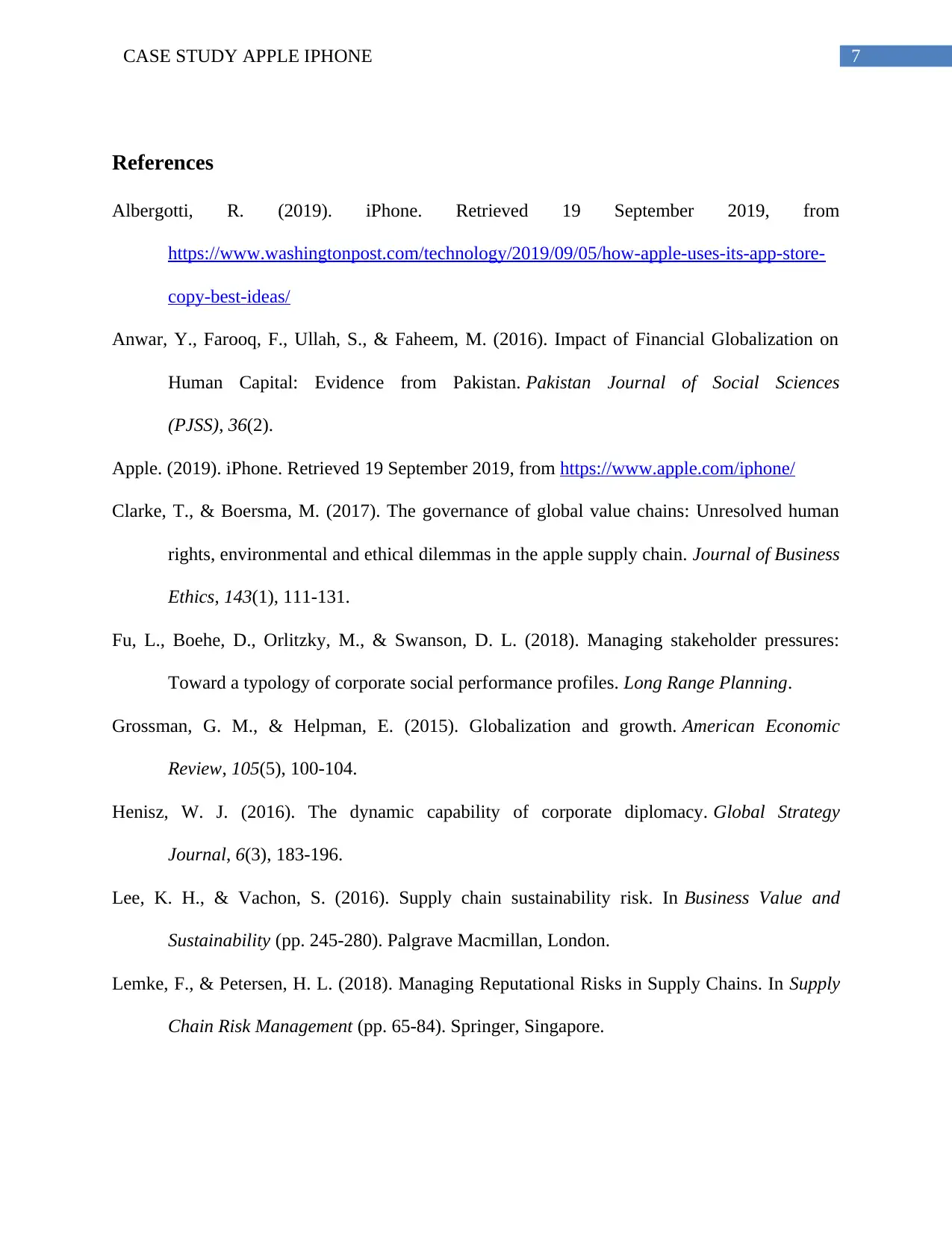
7CASE STUDY APPLE IPHONE
References
Albergotti, R. (2019). iPhone. Retrieved 19 September 2019, from
https://www.washingtonpost.com/technology/2019/09/05/how-apple-uses-its-app-store-
copy-best-ideas/
Anwar, Y., Farooq, F., Ullah, S., & Faheem, M. (2016). Impact of Financial Globalization on
Human Capital: Evidence from Pakistan. Pakistan Journal of Social Sciences
(PJSS), 36(2).
Apple. (2019). iPhone. Retrieved 19 September 2019, from https://www.apple.com/iphone/
Clarke, T., & Boersma, M. (2017). The governance of global value chains: Unresolved human
rights, environmental and ethical dilemmas in the apple supply chain. Journal of Business
Ethics, 143(1), 111-131.
Fu, L., Boehe, D., Orlitzky, M., & Swanson, D. L. (2018). Managing stakeholder pressures:
Toward a typology of corporate social performance profiles. Long Range Planning.
Grossman, G. M., & Helpman, E. (2015). Globalization and growth. American Economic
Review, 105(5), 100-104.
Henisz, W. J. (2016). The dynamic capability of corporate diplomacy. Global Strategy
Journal, 6(3), 183-196.
Lee, K. H., & Vachon, S. (2016). Supply chain sustainability risk. In Business Value and
Sustainability (pp. 245-280). Palgrave Macmillan, London.
Lemke, F., & Petersen, H. L. (2018). Managing Reputational Risks in Supply Chains. In Supply
Chain Risk Management (pp. 65-84). Springer, Singapore.
References
Albergotti, R. (2019). iPhone. Retrieved 19 September 2019, from
https://www.washingtonpost.com/technology/2019/09/05/how-apple-uses-its-app-store-
copy-best-ideas/
Anwar, Y., Farooq, F., Ullah, S., & Faheem, M. (2016). Impact of Financial Globalization on
Human Capital: Evidence from Pakistan. Pakistan Journal of Social Sciences
(PJSS), 36(2).
Apple. (2019). iPhone. Retrieved 19 September 2019, from https://www.apple.com/iphone/
Clarke, T., & Boersma, M. (2017). The governance of global value chains: Unresolved human
rights, environmental and ethical dilemmas in the apple supply chain. Journal of Business
Ethics, 143(1), 111-131.
Fu, L., Boehe, D., Orlitzky, M., & Swanson, D. L. (2018). Managing stakeholder pressures:
Toward a typology of corporate social performance profiles. Long Range Planning.
Grossman, G. M., & Helpman, E. (2015). Globalization and growth. American Economic
Review, 105(5), 100-104.
Henisz, W. J. (2016). The dynamic capability of corporate diplomacy. Global Strategy
Journal, 6(3), 183-196.
Lee, K. H., & Vachon, S. (2016). Supply chain sustainability risk. In Business Value and
Sustainability (pp. 245-280). Palgrave Macmillan, London.
Lemke, F., & Petersen, H. L. (2018). Managing Reputational Risks in Supply Chains. In Supply
Chain Risk Management (pp. 65-84). Springer, Singapore.
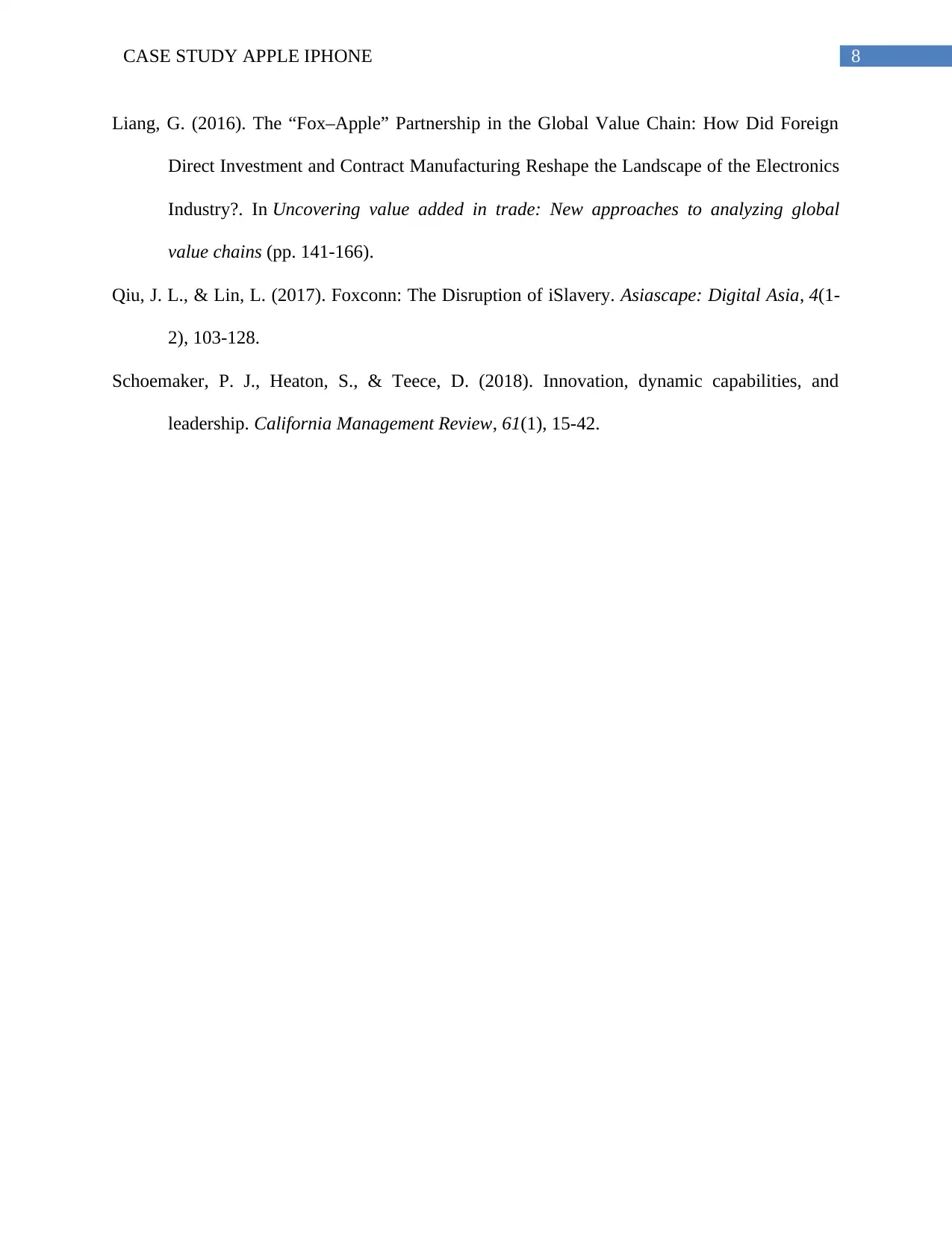
8CASE STUDY APPLE IPHONE
Liang, G. (2016). The “Fox–Apple” Partnership in the Global Value Chain: How Did Foreign
Direct Investment and Contract Manufacturing Reshape the Landscape of the Electronics
Industry?. In Uncovering value added in trade: New approaches to analyzing global
value chains (pp. 141-166).
Qiu, J. L., & Lin, L. (2017). Foxconn: The Disruption of iSlavery. Asiascape: Digital Asia, 4(1-
2), 103-128.
Schoemaker, P. J., Heaton, S., & Teece, D. (2018). Innovation, dynamic capabilities, and
leadership. California Management Review, 61(1), 15-42.
Liang, G. (2016). The “Fox–Apple” Partnership in the Global Value Chain: How Did Foreign
Direct Investment and Contract Manufacturing Reshape the Landscape of the Electronics
Industry?. In Uncovering value added in trade: New approaches to analyzing global
value chains (pp. 141-166).
Qiu, J. L., & Lin, L. (2017). Foxconn: The Disruption of iSlavery. Asiascape: Digital Asia, 4(1-
2), 103-128.
Schoemaker, P. J., Heaton, S., & Teece, D. (2018). Innovation, dynamic capabilities, and
leadership. California Management Review, 61(1), 15-42.
⊘ This is a preview!⊘
Do you want full access?
Subscribe today to unlock all pages.

Trusted by 1+ million students worldwide
1 out of 9
Related Documents
Your All-in-One AI-Powered Toolkit for Academic Success.
+13062052269
info@desklib.com
Available 24*7 on WhatsApp / Email
![[object Object]](/_next/static/media/star-bottom.7253800d.svg)
Unlock your academic potential
Copyright © 2020–2025 A2Z Services. All Rights Reserved. Developed and managed by ZUCOL.





